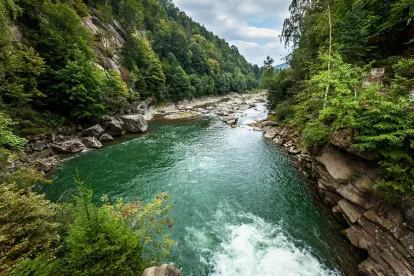DOE Issues HydroVision Report
On July 26, 2016, the Department of Energy (DOE) Office of Energy Efficiency and Renewable Energy (EERE) issued a comprehensive report entitled “Hydropower Vision: A New Chapter for America’s 1st Renewable Electricity Source.” The report analyzes the future of hydropower in the United States with a focus on continued technological innovation, increased energy market value, and environmental sustainability. The report, the product of a collaboration of 300 experts from over 150 organizations and agencies, has four principal objectives: 1) characterizing the current state of domestic hydropower; 2) identifying ways for hydropower to sustain and expand capacity; 3) examining critical environmental and social factors to assess how existing hydropower can minimize adverse effects; and 4) developing a stakeholder roadmap for achieving higher levels of hydropower deployment.
The report highlights the enormous potential of hydropower resources across the nation. The analysis finds that U.S. hydropower can grow from 101 gigawatts (GW) of capacity to nearly 150 GW by 2050, with more than 50% achieved by 2030. This level of hydropower deployment could power more than 35 million U.S. homes, save $209 billion from avoided greenhouse gas emissions, and create over 195,000 hydropower-related jobs. The report does not offer policy advice, but identifies the key factors and drivers that may influence future hydropower trends and outcomes, and sets forth a number of proposed actions for achieving the report’s objectives.
Legislative Update: Energy Bill Heads to Conference
After months of behind the scenes discussions, the Senate voted on July 12th by a vote of 84 to 3 to go to conference with the House of Representatives on the Energy Policy Modernization Act (S. 2012). Seven Senators were appointed as conferees: Energy and Natural Resources Committee Chairman Lisa Murkowski (R-AK) and Ranking Member Maria Cantwell (D-WA), Senators John Barrasso (R-WY), Jim Risch (R-ID), John Cornyn (R-TX), Ron Wyden (D-OR), and Bernie Sanders (I-VT). They join 40 House appointed conferees to resolve the differences between the House and Senate energy bills.
While both the House and Senate are in recess through August, conversations and negotiations have begun between the staff for the House and Senate conferees. There are significant differences between the two bills that need to be reconciled. If negotiations are not concluded during the September work period, the next potential opportunity for a final bill to be considered would be after the elections, during a lame duck session.
FERC and Corps of Engineers Sign Updated MOU to Streamline Hydro Project Permitting
On July 20, 2016, the Federal Energy Regulatory Commission (FERC) and the U.S. Army Corps of Engineers (Corps) executed an updated Memorandum of Understanding (MOU) regarding development of FERC-licensed non-federal hydroelectric projects at Corps facilities. The previous MOU, signed in 2011, contained a general commitment to better coordination of the FERC licensing process and the Corps’ separate dredge and fill permit under Clean Water Act Section 404 and permit to occupy Corps facilities under Section 14 of the Rivers and Harbors Act, also known as Section 408 permits.
The updated MOU establishes a two-phase process for acquiring both agencies’ authorizations. In Phase 1, environmental issues associated with all three authorizations are addressed in a single environmental review document for which FERC is the lead agency. It is contemplated that the FERC license and Section 404 applications would be filed contemporaneously. Following issuance of FERC’s license order the Corps informs the applicant of any additional environmental information needed for the Corps authorizations. When the Corps deems that it has all the environmental information it needs, Phase 2 will begin. In Phase 2, the applicant prepares detailed plans and specifications for the project for submission to the Corps and files its Section 408 application. When the Corps’ environmental and engineering reviews are complete, it issues the Section 408 and Section 404 permits.
The key feature of the process is the Corps’ commitment to proactive early participation in the environmental review, which increases the likelihood that the Corps’ environmental review will be complete or nearly complete when FERC issues its license. The two-phase process is not mandatory; license applicants may instead elect to pursue their FERC and Corps authorizations sequentially.
Ninth Circuit Holds that State Must Repair Stream Culverts that Block Tribal Fishing
On June 27, 2016, the U.S. Court of Appeals for the Ninth Circuit affirmed a lower court ruling requiring the State of Washington to replace or repair stream culverts blocking fish passage in streams throughout the state. The case involves longstanding disputes over the scope of tribal fishing rights under the Stevens Treaties. In the 1850s, a number of Indian tribes in the Pacific Northwest relinquished lands in what is now the State of Washington under the Stevens Treaties, in exchange for a guaranteed right to off-reservation fishing. Litigation concerning the scope of the Tribes’ fishing rights under the Treaties has been ongoing since 1970.
In 2001, the Tribes filed a complaint against Washington State contending that the state had violated, and was continuing to violate, the Treaties by building and maintaining culverts underneath state roads that made it difficult or impossible for fish to move freely through state streams, thereby diminishing salmon runs. The Tribes argued that construction of these culverts has deprived the Tribes of their Treaty-based fishing rights. In 2013, the district court issued a permanent injunction requiring the State to correct its barrier culverts within 17 years, and correct the remainder at the end of their natural life or in the course of independent road construction projects. The Ninth Circuit affirmed the permanent injunction, finding that even if the Treaties did not explicitly guarantee the Tribes access to an adequate supply of fish, the Court would infer that promise to support the purpose of the Treaties. The Court rejected the State’s objections that the injunction was too broad and that the lower court failed to properly consider the significant cost to repair or replace the culverts. The Court’s decision could have far-reaching implications, as the Tribes could attempt to rely on it as a basis to question other activities by the State that potentially impact salmon and their habitat.
For a more in-depth analysis of this landmark case, this post.
FERC Denies 50-Year New License Term; Refines License Term Policy
On July 5, 2016, FERC denied the request for rehearing by Duke Energy Carolinas, LLC (Duke) of the 40-year term established by FERC in the new license for Duke’s 819 MW Catawba-Wateree Project. On rehearing, Duke argued that the new license should have a 50-year term based on the cost of new environmental requirements and costs incurred during the term of the prior license. FERC cited its “long-standing policy” that, in determining an appropriate license term, it only considers measures required for the first time in the new license. Duke contended that a 50-year license was warranted, based on its estimated total annual cost of $30 million for environmental compliance and lost generation, $5 million for environmental improvements under the prior license, and the support of parties to a relicensing settlement agreement.
FERC held that the cost of environmental measures was “not unusual” for a project of this size and that similarly situated projects received 40-year license terms. Although FERC’s policy on new license terms is framed in terms of dollars invested in environmental improvements and/or additional capacity, it stated that its analysis is “qualitative, rather than . . . quantitative” and that it “may use costs as a check on the propriety of our qualitative conclusion that measures required under a new license are minimal, moderate, or extensive.” FERC also questioned the validity of Duke’s cost estimates and rejected inclusion of prior license costs as a consideration. Finally, with respect to Duke’s contention that the settling parties supported a 50-year term, FERC stated that the intentions of settling parties may influence but cannot override FERC’s determination of what license term is in the public interest.
DOE Issues Hydro Funding Opportunities
On July 26, 2016, DOE’s EERE issued, on behalf of the Water Power Technologies Office, a funding opportunity announcement (FOA) called “HydroNEXT FOA: Innovative Technologies to Advance Non‐Powered Dam and Pumped‐Storage Hydropower Development.” The FOA solicits applications that support the development of existing non-powered and pumped storage hydro projects. The two topic areas for this FOA are:
Topic Area 1: Efficient low‐head hydropower turbine/generator technologies with capability to reduce civil works. The topic focuses on new turbine technologies capable of producing water to wire efficiencies above 80%, and should target capital cost reductions of 20% or higher. This topic area will be over two budget periods: Period 1 will include eight awards of $225,000 each; and Period 2 will include two awards of $1.5 million each.
Topic Area 2: Concept feasibility of innovative technologies for closed‐loop pumped storage hydropower systems. This topic seeks applicants that will conceptually demonstrate the feasibility of innovative pumped storage hydropower systems. These systems should not exceed 100 megawatts, be closed-loop, and utilize innovative components to maximize resources and minimize costs. There will be up to four awards of $1.25 million each.
The performance period for Topic Area 1 will be nine months for the first budget period, and 15 months for the second. For Topic Area 2, the performance period is anticipated to be two years.
Important Dates:
-
EERE will hold an informational webinar on the FOA on August 2, 2016.
-
The concept paper submission deadline is August 25, 2016.
-
The full application submission deadline is October 7, 2016.
-
Selected applicants will be notified in January 2017.





 />i
/>i
